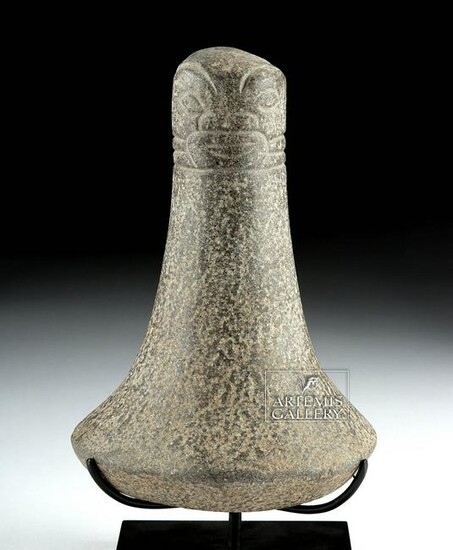18th C. Marquesas Islands Enata Basalt Poi Pounder
French Polynesia, Marquesas Islands, Enata peoples, ca. late 18th to early 19th century CE. An intriguing and elegant poi pounder, hand-carved from dark-grey basalt stone, used for repeatedly pounding taro root into poi. The tool is defined by a rounded pounding face, wide shoulders, a smooth tapered profile, a thick tubular handle, and a bifurcated knob adorned with a pair of carved abstract Janiform faces. Each abstract face is composed of almond-shaped eyes, rectangular noses, and ovoid mouths with full lips, with furrowed eye brows and a mutual set of horizontal scarification lines stretching across the cheeks. Both the handle and pounding face are relatively smooth to the touch as a result of repeated use. Custom museum-quality display stand included. Size: 4.4" W x 6.3" H (11.2 cm x 16 cm); 7.5" H (19 cm) on included custom stand.
Poi pounders, alongside adzes, were the most important stone tools in Polynesia and the Hawaiian Islands (Europeans introduced steel weapons). The pounder, known locally as a "Ke'a Tuki Popoi," are used for pounding cooked taro root into poi, a staple of the islander diet. Taro root was steamed in an earthen oven, peeled using shells, and placed onto a slab of wood to be pounded. The pounded results were blended with water into a highly nutritious paste. Traditional calabash bowls were used as containers to hold poi mixtures, and traveling royalty were accompanied by their own poi maker, with his or her own poi-making implements like this one.
For a similar Janiform example, please see The Metropolitan Museum of Art, accession number 1995.65.1: https://www.metmuseum.org/art/collection/search/317734
Provenance: private Newport Beach, California, USA collection
All items legal to buy/sell under U.S. Statute covering cultural patrimony Code 2600, CHAPTER 14, and are guaranteed to be as described or your money back.
A Certificate of Authenticity will accompany all winning bids.
We ship worldwide to most countries and handle all shipping in-house for your convenience.
#133631
Condition Report: Surface wear and abrasions commensurate with age as expected, very minor nicks to shoulder and handle, minor fading to some carved details, and light roughness across most surfaces, otherwise intact and excellent. Nice earthen deposits and light mineral deposits throughout.
View it on
Estimate
Time, Location
Auction House
French Polynesia, Marquesas Islands, Enata peoples, ca. late 18th to early 19th century CE. An intriguing and elegant poi pounder, hand-carved from dark-grey basalt stone, used for repeatedly pounding taro root into poi. The tool is defined by a rounded pounding face, wide shoulders, a smooth tapered profile, a thick tubular handle, and a bifurcated knob adorned with a pair of carved abstract Janiform faces. Each abstract face is composed of almond-shaped eyes, rectangular noses, and ovoid mouths with full lips, with furrowed eye brows and a mutual set of horizontal scarification lines stretching across the cheeks. Both the handle and pounding face are relatively smooth to the touch as a result of repeated use. Custom museum-quality display stand included. Size: 4.4" W x 6.3" H (11.2 cm x 16 cm); 7.5" H (19 cm) on included custom stand.
Poi pounders, alongside adzes, were the most important stone tools in Polynesia and the Hawaiian Islands (Europeans introduced steel weapons). The pounder, known locally as a "Ke'a Tuki Popoi," are used for pounding cooked taro root into poi, a staple of the islander diet. Taro root was steamed in an earthen oven, peeled using shells, and placed onto a slab of wood to be pounded. The pounded results were blended with water into a highly nutritious paste. Traditional calabash bowls were used as containers to hold poi mixtures, and traveling royalty were accompanied by their own poi maker, with his or her own poi-making implements like this one.
For a similar Janiform example, please see The Metropolitan Museum of Art, accession number 1995.65.1: https://www.metmuseum.org/art/collection/search/317734
Provenance: private Newport Beach, California, USA collection
All items legal to buy/sell under U.S. Statute covering cultural patrimony Code 2600, CHAPTER 14, and are guaranteed to be as described or your money back.
A Certificate of Authenticity will accompany all winning bids.
We ship worldwide to most countries and handle all shipping in-house for your convenience.
#133631
Condition Report: Surface wear and abrasions commensurate with age as expected, very minor nicks to shoulder and handle, minor fading to some carved details, and light roughness across most surfaces, otherwise intact and excellent. Nice earthen deposits and light mineral deposits throughout.



